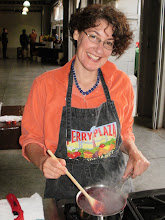Today is my last day in the tiny apartment in Lake Snowbegone, soon to be replaced by an even tinier tent on the top of a hill in Santa Cruz. So, in honor of using up the stuff in the kitchen that K. wouldn't (like lard, yeast, chickpeas, and poppy seeds), I went on a bit of a cooking binge yesterday, making stuffed eggplant with onions, tomatoes, chickpeas, and feta, followed by a puffy loaf of whole-wheat-oatmeal bread and a big apple galette. Mmmm.
The bread was completely made up and thrown together. One packet of dry yeast, dissolved in about 1/2 cup water and thrown into the quart-size empty yogurt container doubling as my whole-wheat flour cannister. There was maybe a cup of flour in there; I mixed in the yeast and water and added enough water to make a goopy batter. Let it rise as a sponge for an hour or so, then stirred it together with more water, a teaspoon or two of salt (honestly, I just poured out some into my hand and dumped it in), an egg because our supermarket carries good marigold-yolked local eggs, about half a cup of rolled oatmeal flakes, a good glug of the Cobble Hill honey Amy gave us as a leaving-Brooklyn present, and enough white flour to make up a smooth dough. Kneaded it, let it rise, rolled it into a ball, let it rise again, then glazed it with egg yolk and sprinkled with poppy seeds, to bake until brown at 350F.
Once you've made bread a bunch of times, you realize that there's no real need for measuring. As long as you have a rough idea of the proportions of water, flour, and salt, you'll get a nice loaf. You can do with a lot less yeast than you think; I usually use one packet for 2 loaves, about half of what most recipes call for. Yes, the rise is slower, but you don't get than beery-yeasty taste that can plague some homemade loaves, and the bread stays fresher longer. I still use recipes when I want to be sure of a particular result, or when I want to try out a new method or combination, but it's relaxing to know that there's no need to get out the cookbooks and teaspoons just to make an ordinary toast-for-breakfast loaf.
Why bring this up? Not to toot my own bread-making horn, for sure. But to encourage all you bakers out there to loosen up in the kitchen. Bread is remarkably forgiving. Short of killing the yeast with too much heat (dissolving it in hot water or using a really hot rising place--for example, don't leave the bowl full of dough on top of the stove when you're preheating the oven), your bread dough is more friendly and flexible than you think.
And the galette was a happy, not really measured treat too. Not having a pie pan or a rolling pin up here, I made do with a Grandma's molasses jar and a cookie sheet. The dough was 2 cups of flour, 1/4 tsp salt, 1 TB of sugar, with 4 oz of Flying Pigs Farm lard and 4 TB (2 oz) of salted butter cut in. Enough cold water to make a just-holding-together dough, flattened and wrapped in plastic wrap and chilled in the fridge for a few hours. Rolled out into a rough circle on the counter, then slid onto the cookie sheet. Peeled and sliced a half-dozen Empire apples, then tossed them with a little raw sugar, some crumbled maple sugar, cinnamon, allspice, nutmeg and a few shakes of salt. Heaped the apple slices in the middle of the pastry, then flapped the dough over the apples, leaving a hole in the middle. Glazed with an egg yolk beaten with 1 TB of water, sprinkled on some more raw sugar, and baked until the crust was deep golden and the apples tender at 400 degrees.
Thanks to the lard, the dough was lovely and flaky, and not as hard to work with as a shorter butter crust.
Now, back out the best coast, and life on the farm!
Subscribe to:
Post Comments (Atom)

1 comment:
Call when you get to town (or nearby, as it were) - safe travels!
Jen
Post a Comment